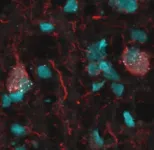(Press-News.org) (Santa Barbara, Calif.) — Every day we encounter circumstances we consider wrong: a starving child, a corrupt politician, an unfaithful partner, a fraudulent scientist. These examples highlight several moral issues, including matters of care, fairness and betrayal. But does anything unite them all?
Philosophers, psychologists and neuroscientists have passionately argued whether moral judgments share something distinctive that separates them from non-moral matters. Moral monists claim that morality is unified by a common characteristic and that all moral issues involve concerns about harm. Pluralists, in contrast, argue that moral judgments are more diverse in nature.
Fascinated by this centuries-old debate, a team of researchers set out to probe the nature of morality using one of moral psychology’s most prolific theories. The group, led by UC Santa Barbara’s René Weber, intensively studied 64 individuals via surveys, interviews and brain imaging on the wrongness of various behaviors.
They discovered that a general network of brain regions was involved in judging moral violations, like cheating on a test, in contrast with mere social norm violations, such as drinking coffee with a spoon. What’s more, the network’s topography overlapped strikingly with the brain regions involved in theory of mind. However, distinct activity patterns emerged at finer resolution, suggesting that the brain processes different moral issues along different pathways, supporting a pluralist view of moral reasoning. The results, published in Nature Human Behaviour, even reveal differences between how liberals and conservatives evaluate a given moral issue.
“In many ways, I think our findings clarify that monism and pluralism are not necessarily mutually exclusive approaches,” said first author Frederic Hopp, who led the study as a doctoral student in UC Santa Barbara’s Media Neuroscience Lab. “We show that moral judgments of a wide range of different types of morally relevant behaviors are instantiated in shared brain regions.”
That said, a machine-learning algorithm could reliably identify which moral category, or “foundation,” a person was judging based on their brain activity. “This is only possible because moral foundations elicit distinct neural activations,” Hopp explained.
The group was guided by Moral Foundations Theory (MFT), a framework for explaining the origins and variation in human moral reasoning. “MFT predicts that humans possess a set of innate and universal moral foundations,” Weber explained. These are generally organized into six categories:
Issues of care and harm,
Concerns of fairness and cheating,
Liberty versus oppression,
Matters of loyalty and betrayal,
Adherence to and subversion of authority,
And sanctity versus degradation.
The framework arranges these foundations into two broad moral categories: care/harm and fairness/cheating emerge as “individualizing” foundations that primarily serve to protect the rights and freedoms of individuals. Meanwhile loyalty/betrayal, authority/subversion and sanctity/degradation form “binding” foundations, which primarily operate at the group level.
The researchers created a model based on MFT to test whether the framework — and its nested categories — was reflected in neural activity. Sixty-four participants rated short descriptions of behaviors that violated a particular set of moral foundations, as well as behaviors that simply went against conventional social norms, which served as a control. An fMRI machine monitored activity across different regions of their brains as they reasoned through the vignettes.
Certain brain regions distinguished moral from non-moral judgment across the board, such as activity in the medial prefrontal cortex, temporoparietal junction and posterior cingulate, among other regions. Participants also took longer to rate moral transgressions than non-moral ones. The delay suggests that judging moral issues may involve a deeper evaluation of an individuals’ actions and how they relate to one’s own values, the authors said.
“Although moral judgments are intuitive at first, deeper judgment requires responses to the six ‘W questions,’” said senior author Weber, director and lead researcher of UCSB’s Media Neuroscience Lab, and a professor in the Departments of Communication and of Psychological and Brain Sciences. “Who does what, when, to whom, with what effect, and why. And this can be complex and takes time.” Indeed, moral reasoning recruited regions of the brain also associated with mentalizing and theory of mind.
The researchers also found that transgressions of loyalty, authority and sanctity prompted greater activity in regions of the brain associated with processing other people’s actions, as opposed to the self. “It was surprising to us how well the organization into ‘individualizing’ versus ‘binding’ moral foundations is reflected on the neurological level in multiple networks,” Weber said.
Next, the authors developed a decoding model that accurately predicted which specific moral foundation or social norm individuals were judging from fine-grained activity pattern across their brains. This would not have been possible if all moral categories were unified at the neurological level, they explained.
“This supports MFT’s prediction that each moral foundation is not encoded in a single ‘moral hotspot,’” the authors write, “but (is instead) instantiated via multiple brain regions distributed across the brain.” This finding suggests that the distinct moral categories proposed by Moral Foundations Theory have an underlying neurologic basis.
In this way, moral reasoning is similar to other mental tasks: it elicits characteristic patterns across the brain, with nuances based on the specifics. For instance, looking at pictures of houses and faces activates a brain region known as the ventral temporal cortex. “However, when looking at the pattern of activation in this region, one can clearly discern whether someone is looking at a house or a face,” Hopp explained. Analogously, moral reasoning activates certain regions of the brain, “yet, the activation patterns in those same regions are highly distinct for different classes of moral behaviors, suggesting that they are not unified.”
Far from merely an esoteric exercise, MFT provides a robust framework for understanding group identity and political polarization. Mounting evidence from survey and behavioral experiments suggests that liberals (progressives) are more sensitive to the categories of care/harm and fairness/cheating, which primarily protect the rights and freedoms of individuals. Conservatives, in contrast, place greater emphasis on the loyalty/betrayal, authority/subversion, and sanctity/degradation categories, which generally operate at the group level.
“Indeed, our results provide evidence at the neurological level that liberals and conservatives have complex differential neural responses when judging moral foundations,” Weber explained. That means individuals at different points along the political spectrum likely emphasize completely different values when evaluating a particular issue.
This paper is part of an avenue of research that the Media Neuroscience Lab embarked on in 2016, aiming to understand how humans make moral judgments, and how the underlying processes vary across more and less realistic scenarios. “the observation that we can reliably decode which moral violation an individual is perceiving also opens exciting avenues for future research: Can we also decode if a moral violation is detected when reading a news story, listening to a radio show, or even when watching a political debate or movie?” Hopp said. “I think these are fascinating questions that will shape the next century of moral neuroscience.”
The study’s co-investigators include renowned neuroscientist and moral philosopher Walter Sinnott-Armstrong from Duke University and Scott Grafton, a professor in UC Santa Barbara’s Department of Psychological and Brain Sciences. Jacob Fisher and Ori Amir also contributed as co-authors, and were, respectively, a Ph.D. student and a postdoctoral fellow in Weber’s Media Neuroscience Lab at the time the work was conducted.
Ultimately, the researchers say, our ability to cooperate in groups is guided by systems of moral and social norms, and the rewards and punishments that result from adhering to or violating them. “For millennia, fables and fairy tales, nursery rhymes, novels, and even ‘the daily news’ all weave a tapestry of what counts as good and acceptable or as bad and inacceptable,” Weber said. “Our results contribute to a better understanding of what moral judgments are, how they are processed, and how they can be predicted across different groups.”
END
Moral reasoning displays characteristic patterns in the brain
Distinctions found between moral categories and individuals of different ideologies
2023-09-07
ELSE PRESS RELEASES FROM THIS DATE:
Echoes of extinctions: novel method unearths disruptions in mammal trait-environment relationships
2023-09-07
Large-bodied mammals play crucial roles in ecosystems. They create habitats, serve as prey, help plants thrive, and even influence how wildfires burn. But now, fewer than half of the large mammal species that were alive 50,000 years ago exist today, and those that remain are threatened with extinction from intensifying climate change and human activities.
While mammal extinctions are well-documented, very little research has explored the impact those losses had on the nuanced ways in which mammal communities interact with their environments. Researchers at the Georgia Institute of Technology are using a novel methodology to investigate how mammals’ ability to function in their environments ...
Specialized T cells in the brain slow progression of Alzheimer’s disease
2023-09-07
(MEMPHIS, Tenn. – September 07, 2023) As many as 5.8 million Americans are currently living with Alzheimer’s disease, a neurodegenerative condition associated with progressive cognitive decline, including loss of memory capabilities . Protein aggregates, composed of beta-amyloid or other proteins, form in the brains of individuals with Alzheimer’s. These beta-amyloid plaques appear to be a significant contributor to the disease. St. Jude Children’s Research Hospital scientists uncovered a subset of immune cells that appears to slow this beta-amyloid plaque accumulation ...
KERI, transfer of ‘ion implantation evaluation technology for the SiC power semiconductor’ to Hungary
2023-09-07
KERI succeeded in transferring the ‘Ion Implantation and its Evaluation Technology for the SiC (silicon carbide) Power Semiconductor’ to a Hungarian company.
Power semiconductors are key components in electricity and electronics, acting as the muscles of the human body by regulating the direction of current and controlling power conversion. There are many different materials for power semiconductors. Among them, SiC is receiving the most attention due to its excellent material properties, including high durability and excellent power efficiency. When SiC power ...
VCU liver institute director leads review of noninvasive tests that could be alternatives to painful biopsies
2023-09-07
By A.J. Hostetler
Led by the director of Virginia Commonwealth University’s Stravitz-Sanyal Institute of Liver Disease and Metabolic Health, a consortium studying noninvasive tests for liver disease has demonstrated the effectiveness of five noninvasive tests, a significant milestone on the path to regulatory approval.
In an article published today in the journal Nature Medicine, institute director Arun Sanyal, M.D., a professor at the VCU School of Medicine, and colleagues report on five biomarker tests that potentially could be given to patients who may have ...
Early access to testosterone therapy in transgender and gender-diverse adults seeking masculinization
2023-09-07
About The Study: In this randomized clinical trial including 64 transgender and gender-diverse adults, immediate testosterone therapy compared with no treatment significantly reduced gender dysphoria, depression, and suicidality in transgender and gender-diverse individuals desiring testosterone therapy.
Authors: Ada S. Cheung, M.B.B.S., Ph.D., of Austin Health in Heidelberg, Victoria, Australia, is the corresponding author.
To access the embargoed study: Visit our For The Media website at this link https://media.jamanetwork.com/
(doi:10.1001/jamanetworkopen.2023.31919)
Editor’s Note: Please see the article for ...
Analysis of heat exposure during pregnancy and severe maternal morbidity
2023-09-07
About The Study: Long- and short-term heat exposure during pregnancy was associated with higher risk of severe maternal morbidity in this study with 403,000 pregnancies from 2008 to 2018 in Southern California. These results might have important implications for severe maternal morbidity prevention, particularly in a changing climate.
Authors: Jun Wu, Ph.D., of the University of California, Irvine, is the corresponding author.
To access the embargoed study: Visit our For The Media website at this link https://media.jamanetwork.com/
(doi:10.1001/jamanetworkopen.2023.32780)
Editor’s Note: Please ...
Calcium channel blocker use and associated glaucoma and related traits
2023-09-07
About The Study: Calcium channel blocker use was adversely associated with glaucoma prevalence in this study of 427,000 adult UK Biobank participants, suggesting that calcium channel blockers may represent an important modifiable risk factor for glaucoma, potentially through an intraocular pressure–independent mechanism.
Authors: Alan Kastner, M.D., M.Sc., of the Moorfields Eye Hospital National Health Service Foundation Trust and University College London Institute of Ophthalmology in London, is the corresponding author.
To access the embargoed study: Visit our For The Media website at this link https://media.jamanetwork.com/
(doi:10.1001/jamaophthalmol.2023.3877)
Editor’s ...
Phase I clinical trial shows treatment designed to clear senescent cells in Alzheimer’s disease is safe
2023-09-07
WINSTON-SALEM, N.C. – Sept. 7, 2023 – Alzheimer’s disease is the most common cause of dementia that affects more than 6.5 million Americans, according to the Alzheimer’s Association. To find effective treatments and slow the progression of this debilitating disease, researchers have made much progress in developing new drugs that target beta-amyloid plaques, one of the hallmarks of Alzheimer’s disease.
Beta-amyloid plaques are accumulations of brain protein fragments, which can impact cognition. However, these recent drugs have only yielded modest results.
Now, ...
Ravenous black hole consumes three Earths’-worth of star every time it passes
2023-09-07
A star like our own Sun in a nearby galaxy is gradually being eaten away by a small but ravenous black hole, losing the equivalent mass of three Earths every time it passes close.
The discovery by University of Leicester astronomers is reported today (7 September) in Nature Astronomy and provides a ‘missing link’ in our knowledge of black holes disrupting orbiting stars. It suggests a whole menagerie of stars in the process of being consumed that still lie undiscovered.
The team was supported by the UK Space Agency and the UK Science and technology Facilities Council (STFC).
The astronomers were alerted to ...
MIT engineers design more powerful RNA vaccines
2023-09-07
CAMBRIDGE, MA -- RNA vaccines against Covid-19 have proven effective at reducing the severity of disease. However, a team of researchers at MIT is working on making them even better. By tweaking the design of the vaccines, the researchers showed that they could generate Covid-19 RNA vaccines that produce a stronger immune response, at a lower dose, in mice.
Adjuvants are molecules commonly used to increase the immune response to vaccines, but they haven’t yet been used in RNA vaccines. In this study, the MIT researchers engineered both the nanoparticles used to deliver the Covid-19 antigen, and the antigen itself, to boost the immune response, ...
LAST 30 PRESS RELEASES:
Tracing the quick synthesis of an industrially important catalyst
New software sheds light on cancer’s hidden genetic networks
UT Health San Antonio awarded $3 million in CPRIT grants to bolster cancer research and prevention efforts in South Texas
Third symposium spotlights global challenge of new contaminants in China’s fight against pollution
From straw to soil harmony: International team reveals how biochar supercharges carbon-smart farming
Myeloma: How AI is redrawing the map of cancer care
Manhattan E. Charurat, Ph.D., MHS invested as the Homer and Martha Gudelsky Distinguished Professor in Medicine at the University of Maryland School of Medicine
Insilico Medicine’s Pharma.AI Q4 Winter Launch Recap: Revolutionizing drug discovery with cutting-edge AI innovations, accelerating the path to pharmaceutical superintelligence
Nanoplastics have diet-dependent impacts on digestive system health
Brain neuron death occurs throughout life and increases with age, a natural human protein drug may halt neuron death in Alzheimer’s disease
SPIE and CLP announce the recipients of the 2025 Advanced Photonics Young Innovator Award
Lessons from the Caldor Fire’s Christmas Valley ‘Miracle’
Ant societies rose by trading individual protection for collective power
Research reveals how ancient viral DNA shapes early embryonic development
A molecular gatekeeper that controls protein synthesis
New ‘cloaking device’ concept to shield sensitive tech from magnetic fields
Researchers show impact of mountain building and climate change on alpine biodiversity
Study models the transition from Neanderthals to modern humans in Europe
University of Phoenix College of Doctoral Studies releases white paper on AI-driven skilling to reduce burnout and restore worker autonomy
AIs fail at the game of visual “telephone”
The levers for a sustainable food system
Potential changes in US homelessness by ending federal support for housing first programs
Vulnerability of large language models to prompt injection when providing medical advice
Researchers develop new system for high-energy-density, long-life, multi-electron transfer bromine-based flow batteries
Ending federal support for housing first programs could increase U.S. homelessness by 5% in one year, new JAMA study finds
New research uncovers molecular ‘safety switch’ shielding cancers from immune attack
Bacteria resisting viral infection can still sink carbon to ocean floor
Younger biological age may increase depression risk in older women during COVID-19
Bharat Innovates 2026 National Basecamp Showcases India’s Most Promising Deep-Tech Ventures
Here’s what determines whether your income level rises or falls
[Press-News.org] Moral reasoning displays characteristic patterns in the brainDistinctions found between moral categories and individuals of different ideologies




